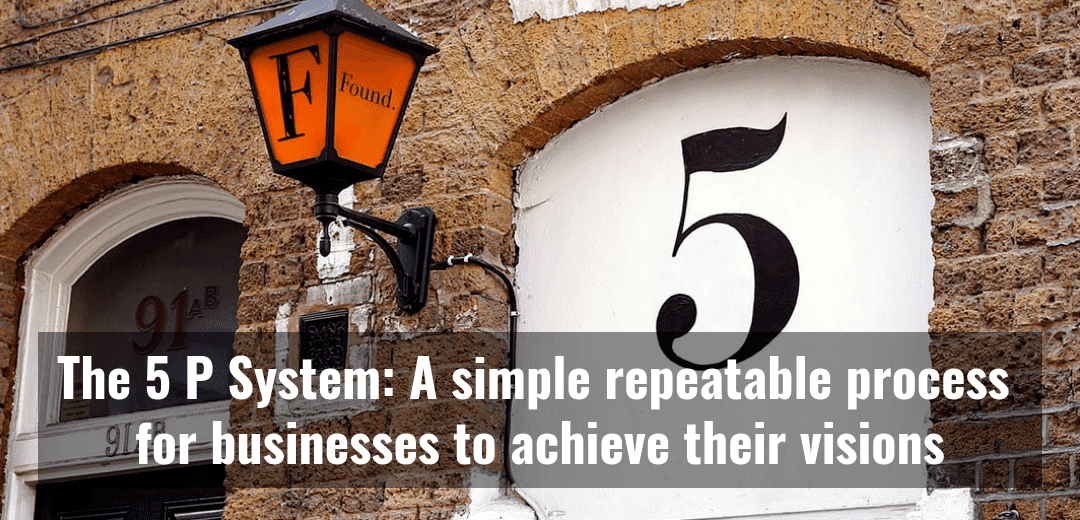Vision and Mission Statements Are Not Enough — You Need A System to Run and Improve Your Business [Using the 5 P’s]

Using the 5 P System, businesses have an effective way to make their vision a reality.
Where do you see your business in five years? How about ten years?
Your business might be doing well right now, but that doesn’t mean you sit back in your comfort zone. You need to have a vision and mission for your brand — one that aligns with the purpose and values of your business. By having a clear dream, not only will you feel more inspired to push your company goals, but also motivate your employees to help you actualize your ideas.
Statistics show that about 70 percent of business executives believe that embracing company’s mission helps boost the productivity of employees. Moreover, according to Forbes, staff that find your organization’s vision to be meaningful are likely to have a 68% engagement score.
But the main question remains.
How do you create a vision and mission for your organization?
And more importantly, how do you use them to ensure that your business not only runs smoothly today, but also is prepared to handle whatever the future may bring?
It’s easy to come up with the “ingredients” for writing a vision or mission statement, but the final product won’t be as you anticipated if there is no follow-through or if they are not aligned with your actual business model.
Think of it like a recipe for baking a cake. You can have the eggs, flour, sugar and flavorings. But what happens if your oven isn’t working correctly? Or if you don’t mix the ingredients together in the right order? Or worse yet, the recipe doesn’t even come with any instructions on what to do with everything?
The same holds true for writing vision and mission statements.
Your Vision Statement Sucks | Cameron Herold | TEDxVancouver
Someone can give you the steps, but if they are not based upon a solid strategic plan, and accompanied with a system to move forward, they are just words on a piece of paper.
Five P’s for Effectively Managing Your Business and Working Your Vision
Let’s take a look at five factors, all of which begin with the letter “P” that are directly related to the success or failure of any business.
The planning process begins with the owner creating a Personal Vision for his/her own life. It has nothing to do with the business, but everything to do with personal dreams, goals, and timetables. The purpose of the Personal Vision is to make certain that the Vision for the organization (created later) does not present a conflict with the personal dreams of the owner.Bill Matthews
Planning
Begin by planning — not as a one-time thing, but as a continuous process.
Your business improves through continuous improvement, but you need to structure a process that will help steer it in the right direction. Keep updating the plan as needed, ensuring that it aligns with your overall objectives, team morale, and your management tools.
Remember, the implementation of your plans is bound to change with time. It needs constant evaluation so that you can implement some changes to enable further development. Planning allows you to streamline your workflows, reduce operation overhead, and, ultimately, grow and add customers!
People Who Fit
You have the perfect plan, right? Well, the next thing is getting the right people for the job.
It can be costly — both in terms of lower employee productivity and business interruption — if you make poor hiring decisions.
Culture fit is a unifying element holding everyone in your organization together. As a business owner or executive, focus on hiring people who fit within your culture. By doing this, you are going to improve your employee retention, enhance their performance, considering that they will share similar aspirations and values, and inspire them to view leadership in a positive manner.
You also want to make sure that your employees understand the “why” behind the company vision and mission.
How to Write a Mission Statement That Doesn't Suck | Dan Heath | Fast Company
Processes
This one is a no-brainer for both small established organizations, but it has to be done right to be effective!
You need to have a well-documented business process management in place, which is regularly evaluated and changed in order to align with the ever-changing business demands. You can call it a business blueprint through which your company values or mission is achieved.
Don’t confuse business processes with a plan. Processes are supposed to breakdown your business activities into distinct and repeatable tasks, all designed to help your organization achieve reliability and consistency.
So, what do you get with business process management? One benefit for your organization is improved business agility. You are able to react to changes that may come from things like advancement in technology or upstart in competitors.
If the business processes function smoothly, you also get increased efficiency and better compliance and security.
Performetrics
Performance and metrics = Performetrics!
This simply means having a better view of what’s important and measurable for your business. You need to keep track of your key performance indicators (KPIs) to determine if your business is on the right track. If the metrics show that it’s not, then you can create a plan for streamlining things back on track.
Give your employees — both on a team and personal levels — a performance metric that connects to their target. Once they know what they are needed to do and what are important, chances are they will be more engaged, and that’s how your business succeeds at the end of the day.
Passion
The last “P” is Passion!
This might not look like an important item for the checklist, but it adds some juice in your journey to achieving your vision and mission. Let’s say it’s a secret ingredient.
Passionate business owners tend to get there quicker because chances of regressing from the journey are extremely low. Thanks to the passion, they strive to remain on top.
Sadly, passion is something you can’t force or fake. Either you have it or don’t! Even your employees or customers can feel it. Of course, it would be a plus to have passion for what you do, but if you don’t, try getting people that possess not just skills, but also passion in their respective fields.
Passionate business owners tend to get there quicker because chances of regressing from the journey are extremely low. Thanks to the passion, they strive to remain on top.
You see?
Creating a vision and mission for your business is more than just writing your ideas down, hoping to achieve each one of them. The five “Ps” we have talked about tend to work better if you follow them to the letter.
Start by creating a workable plan that you can evaluate and change with time as the business world evolves, and then work through the other “Ps”.
Ready for a consultation? Have a question?
